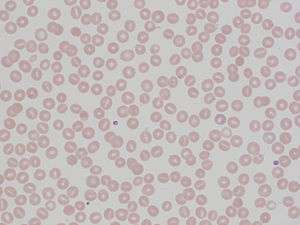Hereditary stomatocytosis
Hereditary stomatocytosis describes a number of inherited autosomal dominant human conditions which affect the red blood cell, in which the membrane or outer coating of the cell 'leaks' sodium and potassium ions.
| Hereditary stomatocytosis | |
|---|---|
 | |
| Stomatocytes | |
| Specialty | Hematology |
Causes
The cause for these hereditary conditions is now understood to be various mutations in the erythrocyte membrane protein, band 3. It is this protein which mediates the cation leaks which are characteristic of this disease.[1]
Pathophysiology
Osmosis leads to the red blood cell having a constant tendency to swell and burst. This tendency is countered by manipulating the flow of sodium and potassium ions. A 'pump' forces sodium out of the cell and potassium in, and this action is balanced by a process called 'the passive leak'. In the hereditary stomatocytoses, the passive leak is increased and the cell becomes swamped with salt and water. The cell lyses and a haemolytic anaemia results. For as yet unknown reasons, the cells take on the shape of a cup, with a 'mouth-shaped' (stoma) area of central pallor. The two varieties of stomatocytosis classified with respect to hydration status are overhydrated (hydrocytosis) and dehydrated (xerocytosis).
Diagnosis
Variants
Haematologists have identified a number of variants. These can be classified as below.
- Overhydrated hereditary stomatocytosis
- Dehydrated HSt (hereditary xerocytosis; hereditary hyperphosphatidylcholine haemolytic anaemia)
- Dehydrated with perinatal ascites
- Cryohydrocytosis
- 'Blackburn' variant.
- Familial pseudohyperkalaemia
There are other families that do not fall neatly into any of these classifications.[2]
Stomatocytosis is also found as a hereditary disease in Alaskan malamute and miniature schnauzer dogs.[3]
Treatment
At present there is no specific treatment. Many patients with haemolytic anaemia take folic acid (vitamin B9) since the greater turnover of cells consumes this vitamin. During crises transfusion may be required. Clotting problems can occur for which anticoagulation may be needed. Unlike hereditary spherocytosis, splenectomy is contraindicated.
References
- Bruce LJ, Robinson HC, Guizouarn H, et al. (2005). "Monovalent cation leaks in human red cells caused by single amino-acid substitutions in the transport domain of the band 3 chloride-bicarbonate exchanger, AE1". Nat. Genet. 37 (11): 1258–63. doi:10.1038/ng1656. PMID 16227998.
- Oski FA, Naiman JL, Blum SF, et al. (1969). "Congenital hemolytic anemia with high-sodium, low-potassium red cells. Studies of three generations of a family with a new variant". N. Engl. J. Med. 280 (17): 909–16. doi:10.1056/NEJM196904242801701. PMID 4237839.
- Thrall, MA (2006). "Veterinary Hematology and Clinical Chemistry, Blackwell Publishing": 71–72. Cite journal requires
|journal=(help)
Further reading
- Eber SW, Lande WM, Iarocci TA, et al. (1989). "Hereditary stomatocytosis: consistent association with an integral membrane protein deficiency". Br. J. Haematol. 72 (3): 452–5. doi:10.1111/j.1365-2141.1989.tb07731.x. PMID 2765409.
- Hiebl-Dirschmied CM, Adolf GR, Prohaska R (1991). "Isolation and partial characterization of the human erythrocyte band 7 integral membrane protein". Biochim. Biophys. Acta. 1065 (2): 195–202. doi:10.1016/0005-2736(91)90230-6. PMID 1711899.
- Hiebl-Dirschmied CM, Entler B, Glotzmann C, Maurer-Fogy I, Stratowa C, Prohaska R (1991). "Cloning and nucleotide sequence of cDNA encoding human erythrocyte band 7 integral membrane protein". Biochim. Biophys. Acta. 1090 (1): 123–4. doi:10.1016/0167-4781(91)90047-P. PMID 1883838.
- Stewart GW, Hepworth-Jones BE, Keen JN, Dash BC, Argent AC, Casimir CM (1992). "Isolation of cDNA coding for an ubiquitous membrane protein deficient in high Na+, low K+ stomatocytic erythrocytes". Blood. 79 (6): 1593–601. PMID 1547348.
External links
| Classification | |
|---|---|
| External resources |